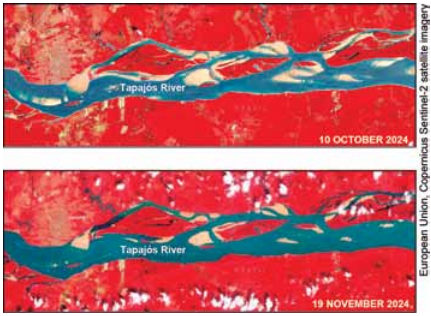Leia o texto e examine as imagens para responder à questão.

In 2024, Brazil, the world’s largest exporter of soya and corn, faced one of the worst droughts in its recent history. Among the worst affected rivers is the Tapajós, a key artery for grain trade from the state of Mato Grosso, the beating heart of Brazil’s agricultural production.
In October, its water level reached historic lows, forcing the traffic suspension of boats for goods transport. Copernicus Sentinel-2 satellite images clearly show the impact of the crisis. In the image acquired on 10 October, large areas of sand can be seen in the riverbed, a sign of the drastic reduction in water levels. Thanks to the November rains, the river has partially regained its flow, as shown in the image dated 19 November, allowing river transport to resume at 50 per cent of its capacity.
The Copernicus Global Drought Observatory (GDO) monitors and provides data on global drought conditions to support water resource management and emergency response.
(www.copernicus.eu, 02.12.2024. Adaptado.)
No trecho do terceiro parágrafo “provides data on global drought conditions to support water resource management”, o termo sublinhado pode ser substituído, sem alteração de sentido, por:
to = in order to; so as to (para; com vistas a; com a finalidade de)